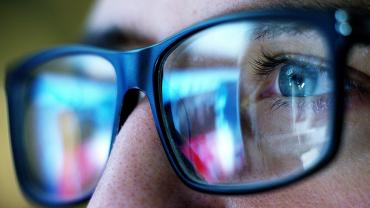
Blue light exposure is increasingly common as screen-based technologies are more interwoven into our society. Manufactured light sources such as mobile phones, LED lights, computers, and other screens emit light in the blue range of the visible spectrum, a wavelength between 400 and 500 nanometers (nm). Based on studies, it has been suggested that prolonged exposure to blue light may be potentially damaging to the eye through photochemical damage to the rod cells, damage to the ocular surface from oxidative stress, and induction of an inflammatory response. Evidence also suggests that blue light overexposure may induce a significant increase in reactive oxygen species production, possibly contributing to lipid peroxidation, cell apoptosis, and damage to DNA, endoplasmic reticula, and mitochondria.
Many nutrients have shown promise for the protection against the hazards of blue light exposure. Lutein and zeaxanthin are nutrients that are deposited in rich concentrations in the macular retina and are classified as macular carotenoids and xanthophylls. Lutein and zeaxanthin are not biosynthesized by primates, but they are found in high concentrations in leafy green vegetables and other fruits and vegetables. They have been shown to modulate oxidative stress and redox balance. Zeaxanthin is the xanthophyll with the highest concentration in the fovea, the part of the eye densely saturated with cone photoreceptors and responsible for high-acuity vision, which has the highest metabolic demand for oxygen out of any tissue in the human body. Most foods contain more lutein than zeaxanthin. However, an exception to this is the goji berry, which has been suggested in studies to increase serum zeaxanthin in patients with early age-related macular degeneration (AMD).
A randomized, placebo-controlled trial assessed the efficacy of a nutraceutical containing lutein and zeaxanthin on individuals who spend at least 6 hours per day viewing screens at 3 feet or less. The trial assessed visual and physical parameters at baseline, 3 months, and 6 months. After 6 months, the treatment arm experienced significant improvement in eye fatigue, eye strain, headache frequency, total number of undesirable sleep symptoms, and photostress recovery. A similar study lasting 12 months assessed the effect of the same nutraceutical containing lutein and zeaxanthin on psychological stress and serum cortisol levels. Significant improvements were seen in anxiety scores, serum cortisol levels, and psychological stress scores.
Studies suggest that symptoms relating to the hazards of blue light may be improved with supportive macular carotenoids such as lutein and zeaxanthin. Because humans cannot synthesize these compounds, although they are present in high concentrations in the fovea and other parts of the retina, supplementation with these nutrients may support eye health.
By Colleen Ambrose, ND, MAT